Rafting the Grand Canyon
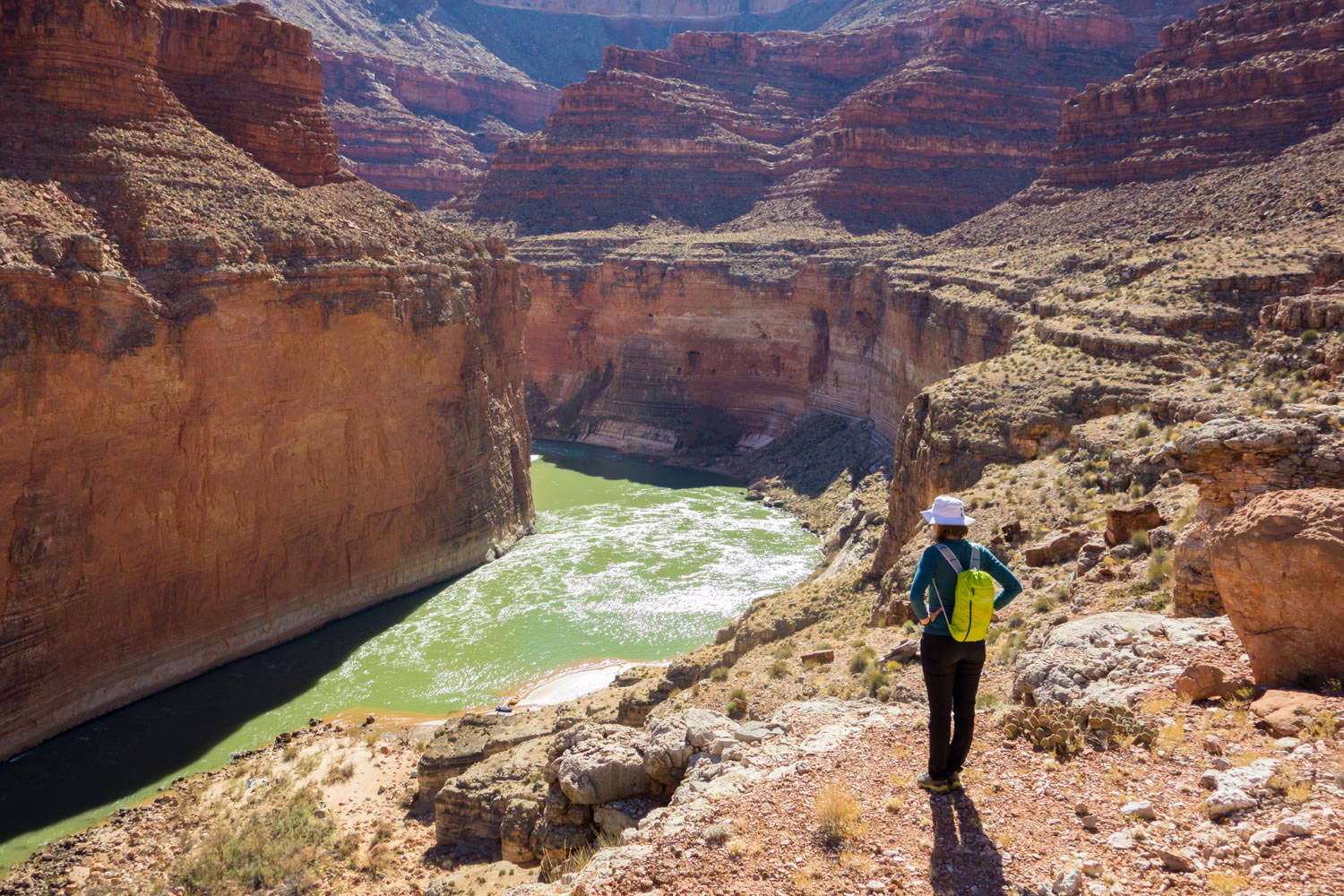
Rafting The Whole Grand Canyon
Essay and Photographs by Kristin McLane
I’m going to raft the Grand Canyon! That was all I could think, on repeat, for a week. I was a last minute addition to the private permit of a friend three times removed, through a connection with a woman I’d met on the Pacific Crest Trail the summer before. I had never met the other five people in the group, and I had only been whitewater rafting once, on a short afternoon in Tennessee. On the bus ride to that put in point, the river guides regaled us with how many ways you could be injured or die if fallen into the rapids. I found it terrifying but thrilling. The thought of a month at the bottom of the Grand Canyon was equally exciting.
On a pre-trip phone call with one of the boatmen in the group, he said that rafting experience was less important than the ability to camp long term, suffer through bad weather, and not complain. Over the past few years, I’ve spent months at a time backpacking, thru hiking the Appalachian and Pacific Crest Trails, and spending time on other smaller trails as well. Suffering experience I had in spades! I immediately signed up.

Day One
We put in on a frigid morning in early February at Lee’s Ferry, sixteen miles below Glen Canyon Dam. The air temperature was in the 20s, and the water temperature was around 46° F. The air would quickly warm with the sun that day, and it would get warmer and warmer throughout the month, as spring approached and we got farther south and lower in elevation on the river. The water temperature also slowly warms as the river moves away from the dam, but only a few degrees.
I prefer to be a contributing member of a team, but there wasn’t much I could do the first day. None of the boats or equipment were mine, and I knew nothing about how to load and rig, fitting everything as low and tight as possible and distributing weight evenly. I don’t like sitting around while other people work so I determined to watch and learn. In camp too, there was a system for unloading the necessary equipment for the night and setting up the kitchen, groover (the ammo can used for a toilet), and fire pan. I learned a little more each day, and soon I was able to do any of the chores needed.
There were four boats and seven people. The rafts ranged in size from fourteen to eighteen feet, with one boatman each on the oars, and a passenger in three of the boats. I worried about just sitting in the bow of the boat and not helping with the rowing, but one of the boatmen was happy to have me learn to row on his boat, and I started the very first day.

I’d had some experience rowing growing up, visiting my grandparents’ New York lake house in the summer and using their row boat. Unlike a standard row boat, river rafts are generally rowed while facing forward so you can see the rapids and obstacles ahead. My backstroke was already good, but my forward stroke started out awkward and weak. At first, I’d only row on flat water, and I’d switch off the oars if even a riffle appeared. I decided my goal for the trip was to row a 2 on the Grand Canyon 1 to 10 rapid scale (separate from the international Class I to VI rapid scale). After a while, I’d stay on the oars through small riffles, steering around rocks and trying to stay in the current. I tended to row too hard or not hard enough, shooting right out of the current into an eddy, and end up stuck while the other boats would float on by, seeming to stay in the current effortlessly. There was much to be learned about reading the water and boat momentum.
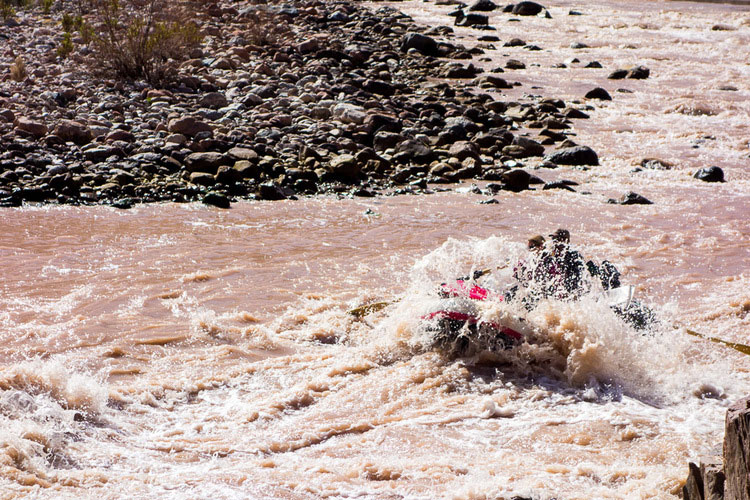 The boatmen on the trip had experience ranging from four to fifty five previous trips down the Colorado River through Grand Canyon, and were a wealth of knowledge. There’s nothing boatmen like more than sharing river stories. From trips leading archaeological and Native American groups, one boatman knew much of the Canyon’s history and the people who had lived there. Others had hilarious stories of joining groups through the internet, where the experience people claimed to have may or may not be true. Tales of boats flipping, passengers swimming, and epic runs through the rapids were frequent topics in river lore. I was variously amazed, tickled, and made nervous by the stories I heard.
The boatmen on the trip had experience ranging from four to fifty five previous trips down the Colorado River through Grand Canyon, and were a wealth of knowledge. There’s nothing boatmen like more than sharing river stories. From trips leading archaeological and Native American groups, one boatman knew much of the Canyon’s history and the people who had lived there. Others had hilarious stories of joining groups through the internet, where the experience people claimed to have may or may not be true. Tales of boats flipping, passengers swimming, and epic runs through the rapids were frequent topics in river lore. I was variously amazed, tickled, and made nervous by the stories I heard.
Rapids in Grand Canyon start out on the smaller side, allowing for a nice easing in of rusty or new boatmen and passengers. On the boat I mainly rode in, I would crouch on the floor of the bow during rapids, holding onto a grab strap on the floor with one hand and balancing my shifting weight on the tubes with the other. I was a little anxious at the beginning, thinking back to my only other rafting experience. Although uneventful, the guides had left a strong impression on me of what could go wrong. Going through the initial small and midsize rapids of the Colorado, I enjoyed them, but I still worried over the bigger rapids to come.
Day 10
It was almost eighty miles before the large rapids of “Adrenaline Alley” began. We pulled over to the side of the river to scout the first one, tied up the boats, and walked down shore a bit so that the boatmen could decide which line they’d use to run the rapid. Hance Rapid is rated an 8 on the Grand Canyon scale, consisting of many boulders, holes, and big waves. I stayed close to the boatmen on the scout, listening to how they described the rapid and trying to connect terminology to feature as they pointed and talked. Once they were set, we walked back to the boats and climbed in.
I gripped the grab strap very tightly as we entered the rapid. It was a shock to go from slowly gliding down the tongue of the current to dropping into the churning waves and rough water quickly moving all around us. I was prepared to shift my weight around and high sided at the right time when a wave caught us from the side, using my body weight to help hold down the side of the raft the wave was trying to throw up. Some of the waves seemed to almost stop us in place, but we ploughed right through as long as we hit them square. I was completely soaked at the end, but I started to realize that running rapids was not scary so much as fun!
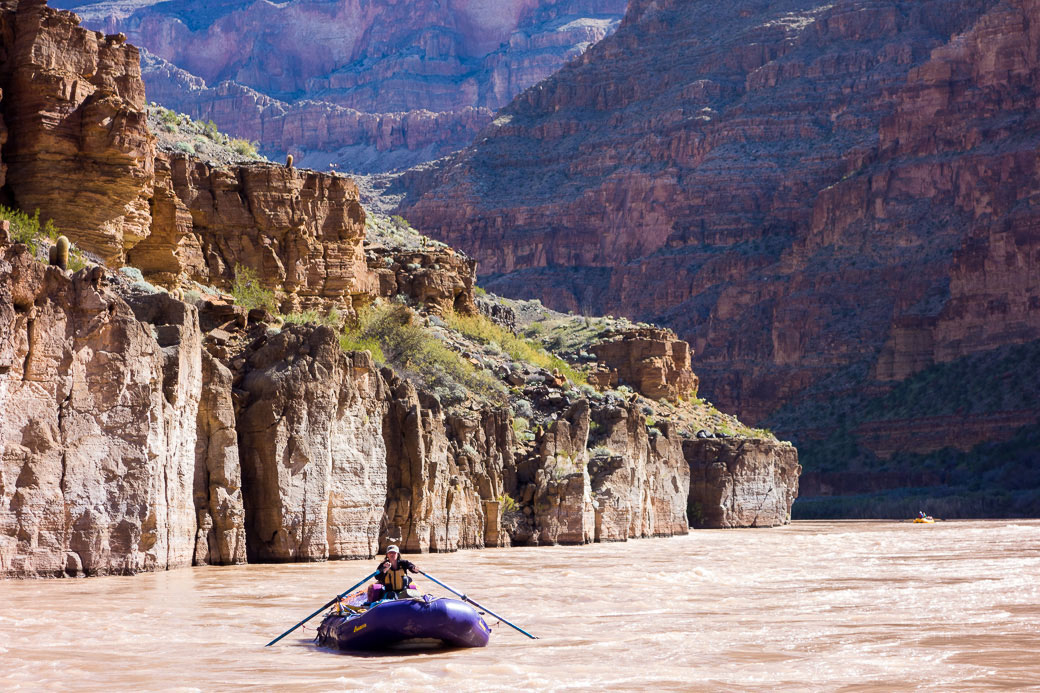
The weather was just about perfect. While February is normally an okay month, with highs in the 40s and 50s at the beginning and highs in 60s at the end of the month, we only had about a week at the colder end of the spectrum, and quickly warmed up to temperatures in the 70s! Even the nights quickly rose from freezing to high 40s. We still wore drysuits on big rapid days on the water, but shorts and tshirts were frequently worn on land. Many of the plants even started budding out by the end of the month. Spring comes early in the Canyon.
Day 13
In addition to the great temperatures, we had only one minute of rain the entire month, and very little wind, a four letter word which is never said aloud as a boatman’s superstition. They wouldn’t want to tempt the fates to throw some UCW – up canyon wind – at us, making the rowing much more difficult and the miles harder to earn. There was really only one day with bad weather on the whole trip.
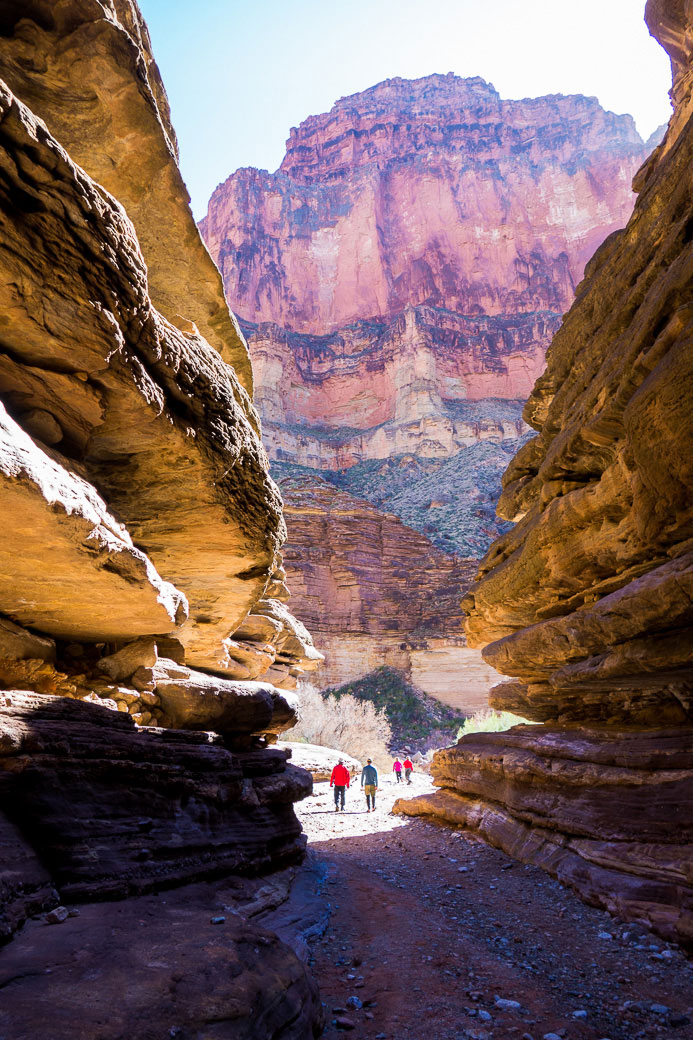 Prompted by that one minute of rain, we raced to set up a canopy over the kitchen before we all left to go hiking. I was hiking in a side canyon, and although there wasn’t much wind in there, I could see the clouds moving faster and faster across the sky. I decided to turn back early because I realized I hadn’t staked my tent down the night before and the wind was worrying me. I got back to camp to see my tent moved, but still upright and in the same general area as I’d left it. I staked it down and picked up my book to go read near the kitchen.
Prompted by that one minute of rain, we raced to set up a canopy over the kitchen before we all left to go hiking. I was hiking in a side canyon, and although there wasn’t much wind in there, I could see the clouds moving faster and faster across the sky. I decided to turn back early because I realized I hadn’t staked my tent down the night before and the wind was worrying me. I got back to camp to see my tent moved, but still upright and in the same general area as I’d left it. I staked it down and picked up my book to go read near the kitchen.
What I saw there was not good. Two of the canopy poles been blown over, along with two out of three tables and everything that had been on them. I could see plates and other small items strewn across the beach and even some in the water. I ran to grab any items in the water and carried them back up to the kitchen, but the gusts kept coming. The canopy was initially still held up by two oars, but as I carried things back from the water, they came crashing down, knocking over the tables I had just righted. The canopy kept whipping around on the ground with the wind, so I rushed to get it untied from all the stakes and bundled it up and threw it in a rock alcove to keep the wind from taking it. Other items I had just saved went blowing down the beach again, as I ran around frantically, trying to collect as much as possible and throw every loose item into the alcove before going back to collect more. Meanwhile, the sand was blowing around just as much as our stuff, blinding me and grating across my skin. I lost some items to the river, as I wasn’t fast enough to grab everything, and we discovered more missing items later when the wind calmed down. I stood watch until everyone else returned from their hikes, and we had a lot of cleanup to do.
Later, I went back to my campsite and discovered that the tent I had staked down was now upside down several feet from where I’d left it. Everything inside had been tumbled around. After maneuvering it back upright and into place, I discovered multiple holes in my tent fly, tent floor, and sleeping pad, not to mention the sand coating everything. It blew through the mesh tent body easily. There was another long cleanup session, and repair as well. From then on, I staked my tent every night.
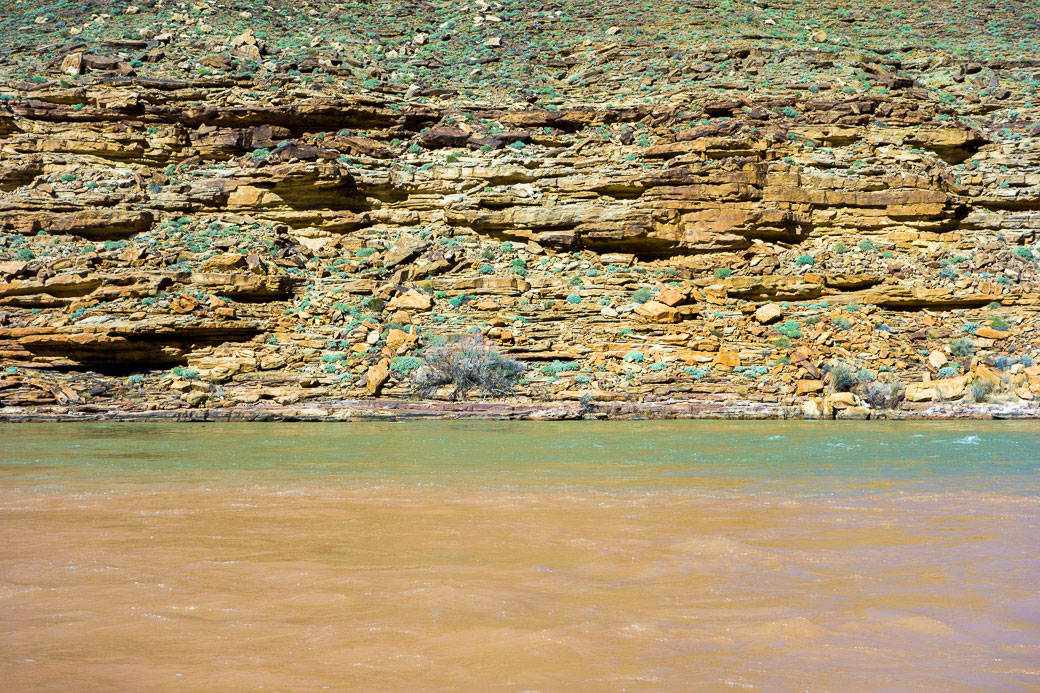
We worked our way down the river, passing through many geologic layers as we lost elevation. With twenty eight days to raft 280 miles, we didn’t have to spend much time on the water each day to make progress, and we frequently took layovers, where we stayed at the same camp two nights in a row in order to relax or go hiking. There are endless side canyons to explore in the Grand, and you can even hike all the way up to the rim from some camps. We had ruins to investigate, wildlife to observe, slot canyons to marvel at, waterfalls to touch, and hidden ferns in cool streams to find.
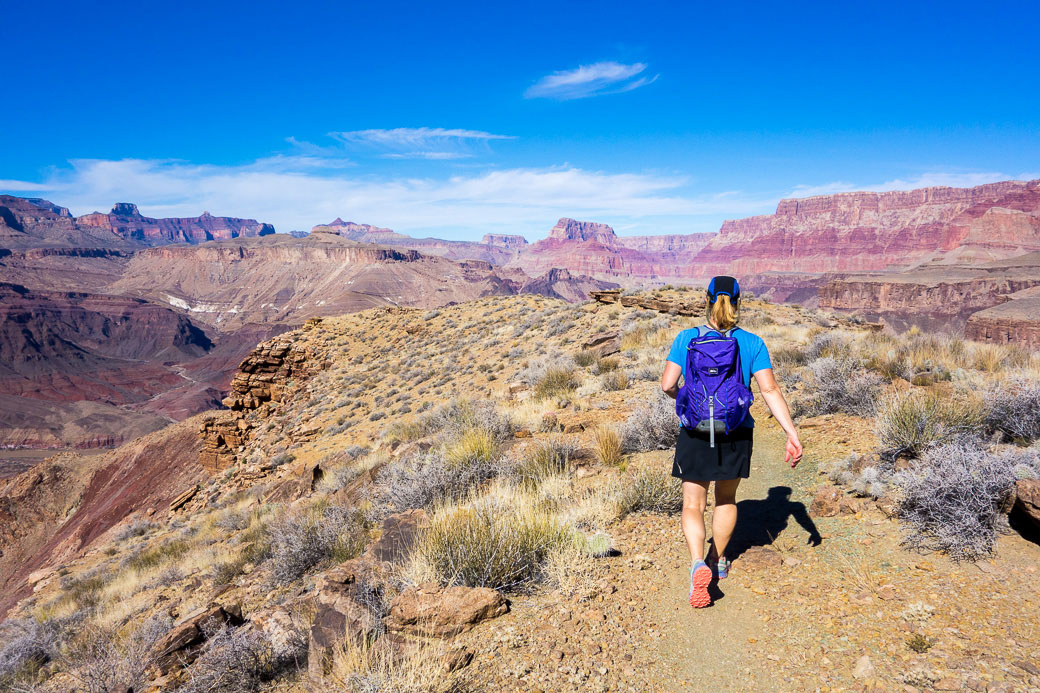
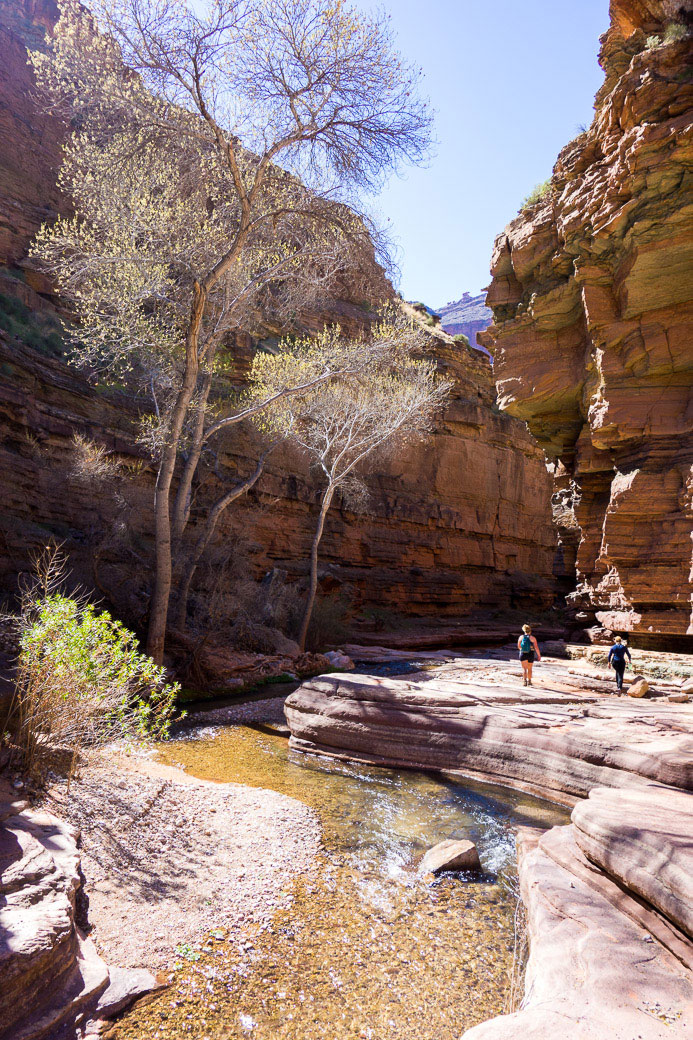
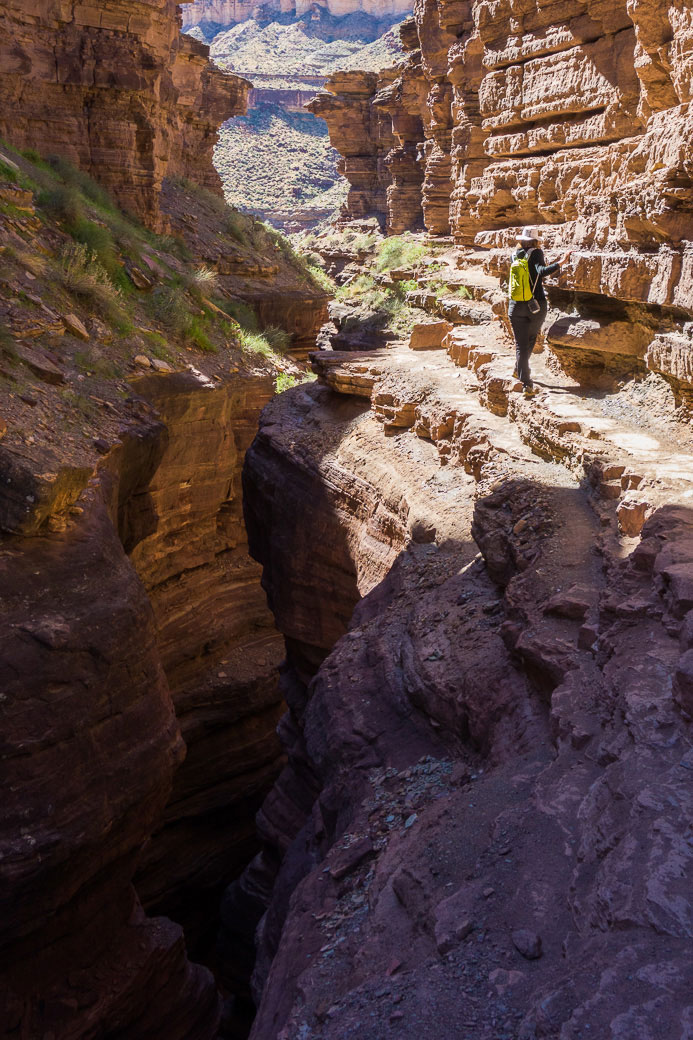
Day 18
Not all hikes have trails to follow. Some side canyons are narrow enough that you can’t go off course. You go up the canyon, and then you turn around and go down the canyon: easy! The only problem that might arise there is that a prior flash flood has blocked off part of the way and you have to turn around early. Other hikes involve overland sidehilling on loose, steep ground, which is not exactly my favorite activity.
On one such hike, we went up one canyon with the intention of going up and over a terrace and back down through a neighboring canyon. The only problem was we weren’t quite sure how high up to go to traverse over to the next canyon and be able to get down into it. It was a long day, and my ankles were relieved to finally stop sidehilling and arrive in the exit canyon. Only, surprise! That canyon had many vertical pourovers that we had to either climb down or navigate around, increasingly difficult in the dimming light of day and then in the dark. Prepared hikers that we are, we had headlamps to guide us, eventually stumbling back into camp for a late dinner.
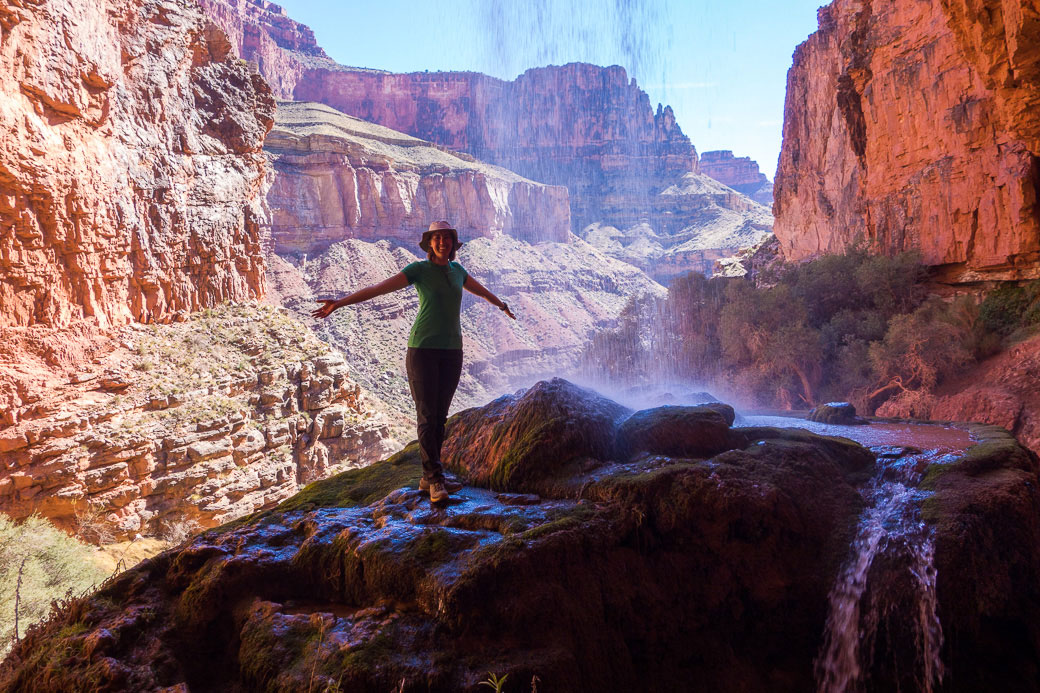
We ate like kings on the trip. No dehydrated camp fare for us, but a smorgasbord of game meats, Dutch oven baked goods, fresh fruits and vegetables, and even dairy! Storing the food at the bottom of the boat allowed the river water to help keep things cool and the ice in our cooler lasted almost the entire month. I was told before the trip that it would be a “float and bloat” affair and that is exactly what happened. I’m used to long distance hiking trips where it’s impossible to eat enough calories. This trip was a nice change. I couldn’t wait to see what was planned for dinner each night.
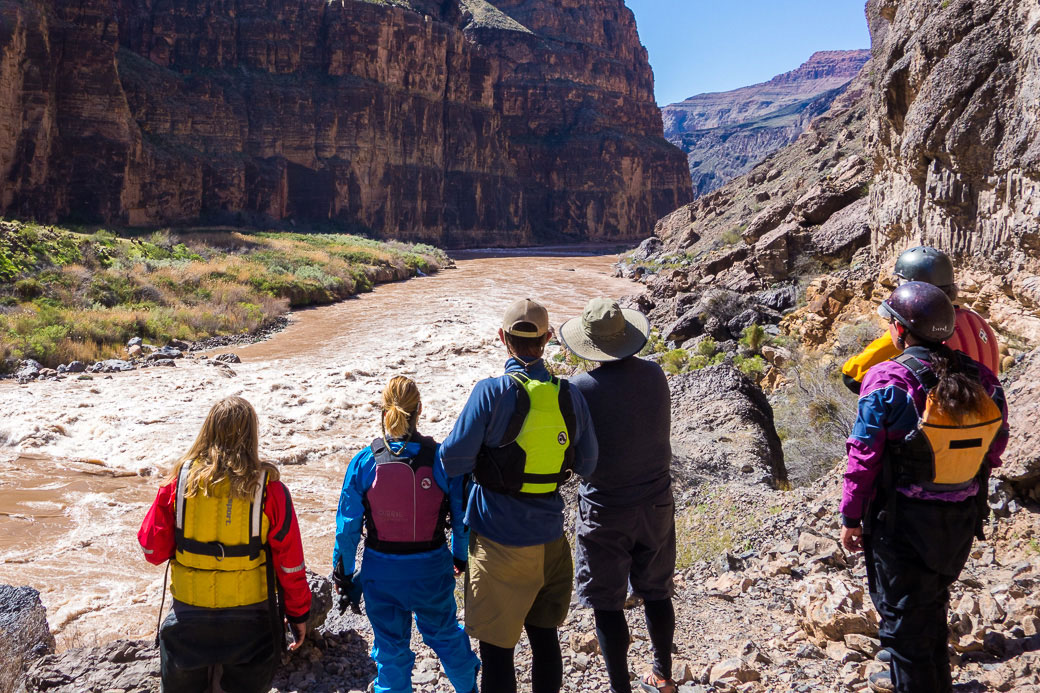
Day 21
There’s a saying on the river in Grand Canyon: “You’re always above Lava.” Lava Falls is the biggest rapid in Grand Canyon, rated a 9. It’s also the most talked about rapid around the campfire. Boatmen start talking about it right from the beginning of the trip, getting antsy as it gets closer. Then once they run it, they repeatedly rehash how it went and start talking about conquering it on the next trip.
The morning we ran Lava, the boatmen all spent extra time rigging their boats, making sure everything was lashed down tightly in case of another dreaded four letter word – the F word – flip – which, superstitiously, is also never mentioned while on the water. We had several miles to go before reaching Lava, and everyone seemed to be rowing as fast as they could to get there. We finally started hearing the roar of white noise that a giant rapid produces: we were there. We pulled over and walked up the scout trail and I got my first view of Lava Falls.
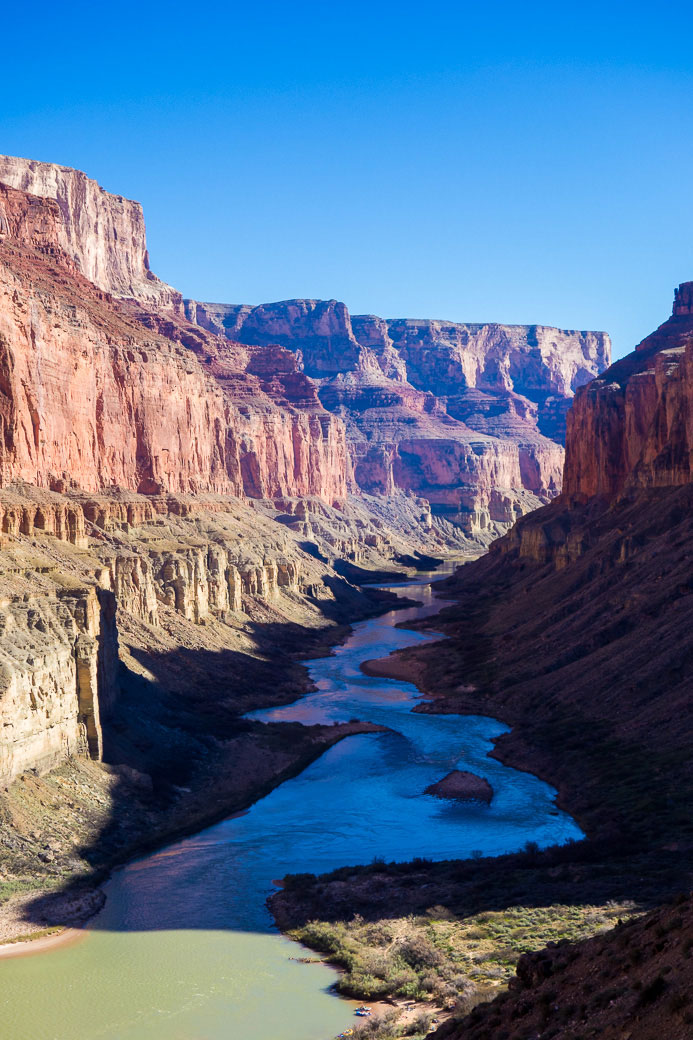 It was both bigger and smaller than I expected it to be. Bigger than any previous rapids for sure, but not quite as big as it had built up in my mind after hearing all the talk about it. Of course, I didn’t know exactly what I was looking at either. I could see rocks and holes and big waves, but I still couldn’t read water well enough to see just how much could go wrong if the boat deviated from the narrow line of safe passage. Ignorance is indeed bliss.
It was both bigger and smaller than I expected it to be. Bigger than any previous rapids for sure, but not quite as big as it had built up in my mind after hearing all the talk about it. Of course, I didn’t know exactly what I was looking at either. I could see rocks and holes and big waves, but I still couldn’t read water well enough to see just how much could go wrong if the boat deviated from the narrow line of safe passage. Ignorance is indeed bliss.
The boatmen talked over their plans and I could tell some of them were nervous. There was much fiddling with rigging, tightening of PFD and helmet straps, and taking of deep breaths. Since I didn’t have to worry about getting a boat through safely, only keeping myself in the boat, I was just excited. Even if I was tossed from the raft, I had been told that the Colorado is generally nice to people. You might get tumbled around some, but it will spit you out. Also, the rapid was less than twenty seconds long, so you wouldn’t be tossed around for long.
I was in the second boat in line, and eager to see how the first boat fared, but as soon as we entered the rapid, I had no time to look anywhere else but at what was hitting us. We took the right line and slipped past the massive Ledge Hole, then hit the V Wave square. It was breaking as we hit it and I was completely underwater for what felt like several seconds. I could hear the water bubbling past my ears and fought to keep my eyes open. The wave pushed me back with such force that if I hadn’t been holding onto the grab strap, I would have gone tumbling backwards into the boatman or off the boat. We broke through and hit the next big wave. It was also breaking and we had to high side our way through it. We made it past the Cheese Grater Rock and rode the wave train the rest of the way down.
I turned around to see how the last two boats were doing and saw one boatman with her feet in the air as she was thrown from her seat and one oar broke free of the oar lock. She held onto the oar but lost precious time rethreading it through the lock, difficult while being tossed around by waves, and couldn’t do any steering until it was back in place. She regained control and made it through, the fourth boat soon following. We ran Lower Lava Rapid, immediately following Lava Falls but only rated a 4, and pulled over at Tequila Beach to celebrate. We were all giddy with success. No flips or swims this time.
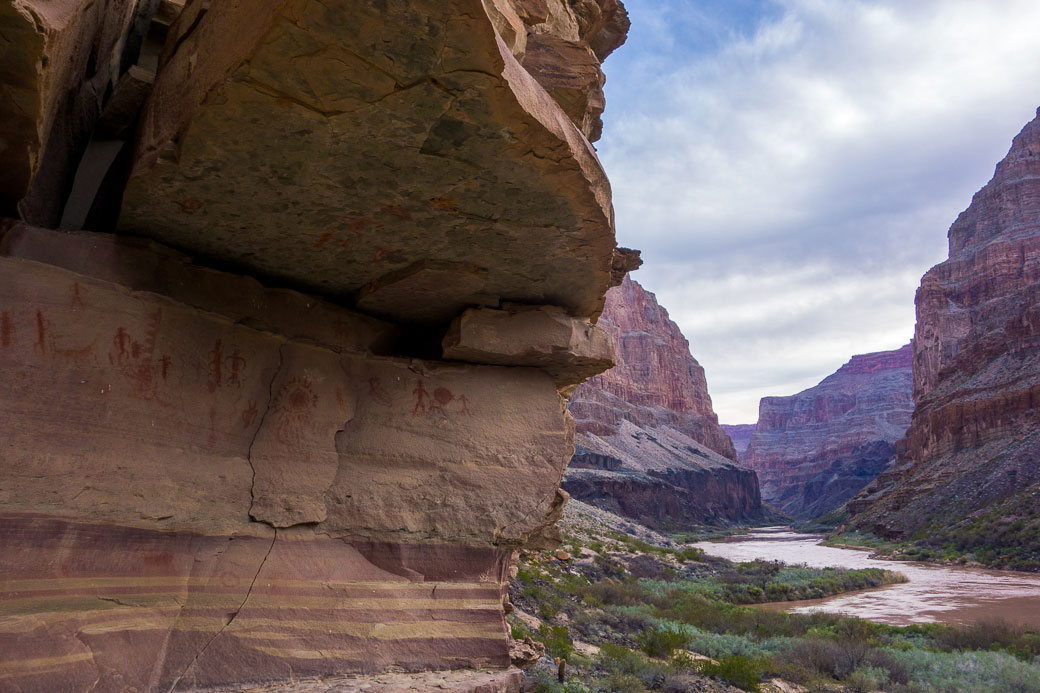
Day 24
Once Lava was out of the way, there weren’t many big rapids left. I had already met my goal of rowing a 2 (two of them!) so it was decided that I had enough experience and acumen to keep moving up. I rowed several 3s, and then skipped the 4s and went right to a 5. 217 Mile Rapid was the one. It had big waves but was otherwise straightforward: no rocks or crazy current. I was nervous but fairly confident that I wouldn’t flip the boat. All I had to do was keep the raft square to the waves and keep pushing. The waves tried to turn the boat and there was one or two where I wasn’t sure I’d get it turned back in time, but we made it through just fine. I was so proud of myself. On a trip where I didn’t think I’d row at all, I had just rowed a fun, midsize rapid! I could see how much I had improved, getting stronger at my forward stroke and better at steering and reading the water.
Towards the end of the river, there were no rapids at all. They’d all been drowned by Lake Mead when the Hoover Dam was built. Since the river is no longer naturally flowing, the sediment that would normally continue being transported downstream is instead deposited in the lake. Lately, the lake is so low from years of drought that you can see the huge deposits of sediment along the mostly vertical banks. We saw and heard those banks collapsing frequently as we floated by, making sure to stay out of their reach.
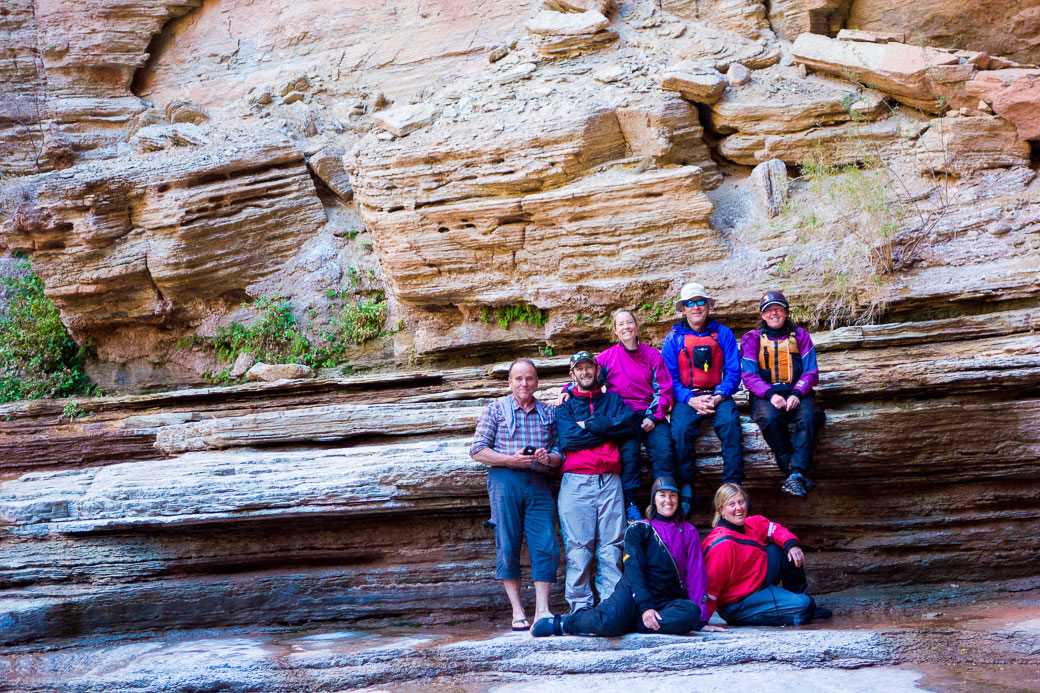
Day 28
On our final day, we rowed down to Pearce Ferry and took the boats out of the water. 280 miles and twenty eight days from when we had put in, I wasn’t quite ready to leave. Sure, I was ready for a shower and a milkshake, but there was so much more to explore in the Canyon.
Grand Canyon is one of those places that grips people. Floating down through the physical evidence of time, you can’t help but be in a constant state of wonderment. You could spend a lifetime down there and not see everything there is to see: side canyons, springs, ruins, wildlife, unique flora, changing water levels and rapids.
I know I’m hooked. And I will be back.
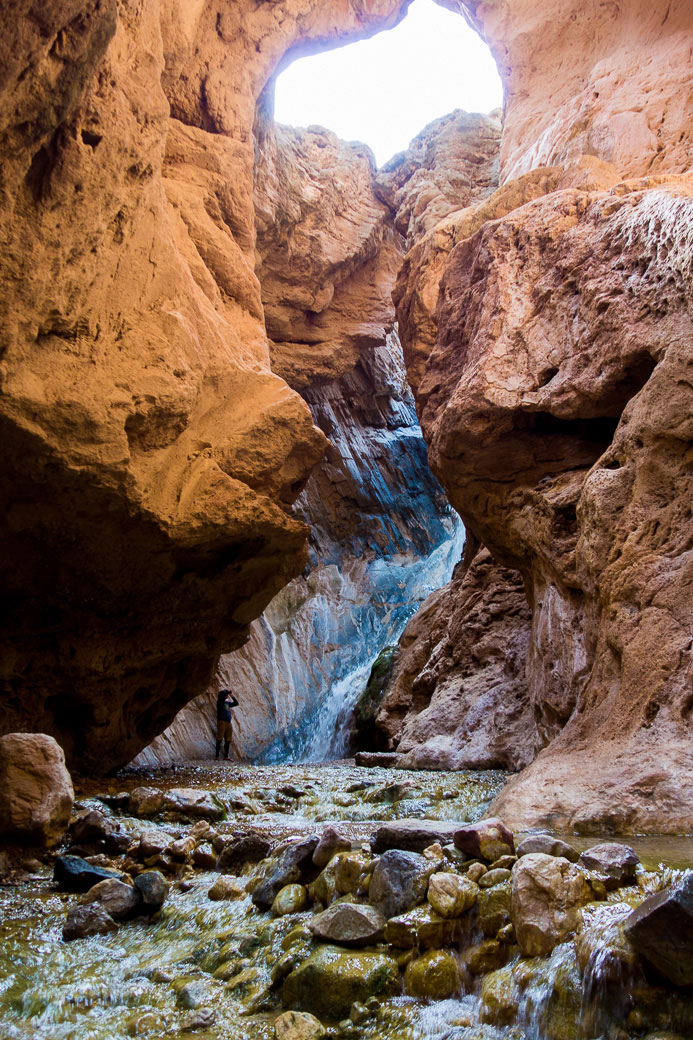
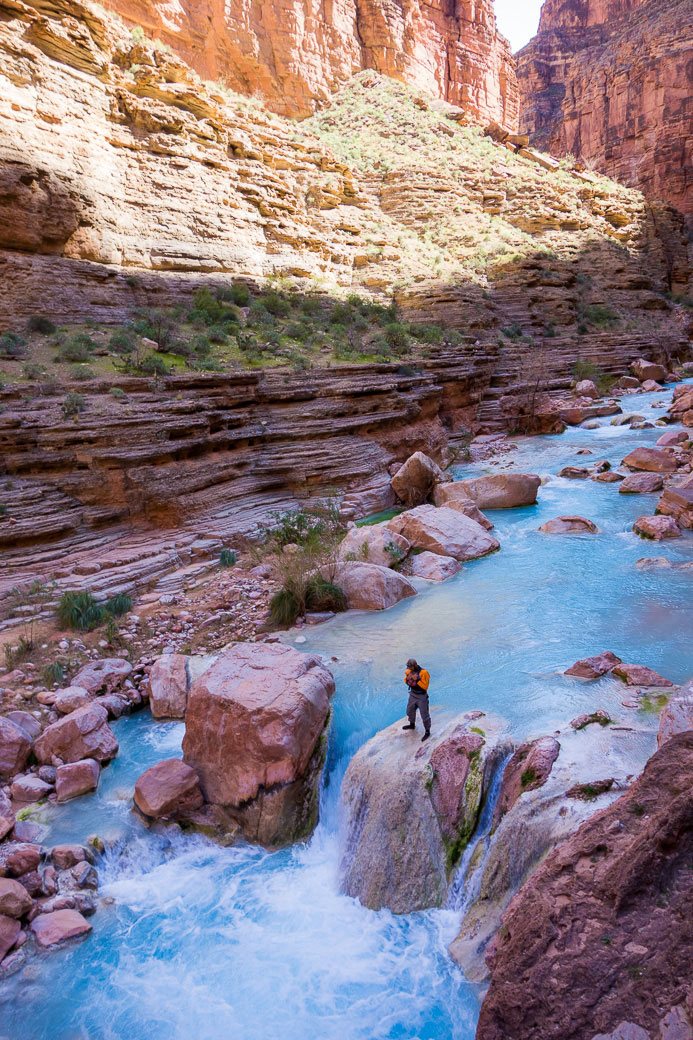
Want To Give It A Shot? Plan Your Trip:
River trips through Grand Canyon are available in lengths from a half day to a month, on oar boats (like I did), paddle boats (where everyone gets to paddle), and motorized boats. The National Park Service requires groups with private permits to have at least one person with commensurate river experience. If you don’t personally know any boatmen, commercial trips of up to eighteen days are available. The NPS website has regulations and a list of authorized river concessioners. Check out these river orientation videos for even more information on how river trips work.
Traveling in the winter, you skip the heat and the crowds. Only one group can launch per day so you rarely see others on the river, and motorized trips are not allowed. Be prepared for rain and even occasional snow in the inner canyon. Summer comes with high heat, making getting wet in the rapids and swimming more enjoyable, and you can skip the dry suits and bulk of warm layers. Just watch out for the frequent thunderstorms. Spring and fall have the most moderate temperatures, although spring tends to have the highest winds. As long as you’re prepared for the conditions, Grand Canyon is beautiful in any season.

Kristin McLane is an outdoor adventurer, thru hiker, wilderness guide, Leave No Trace Master Educator, gear tester, writer, and speaker. Follow along on her travels on her blog, “Wayfarer” and through the links below.
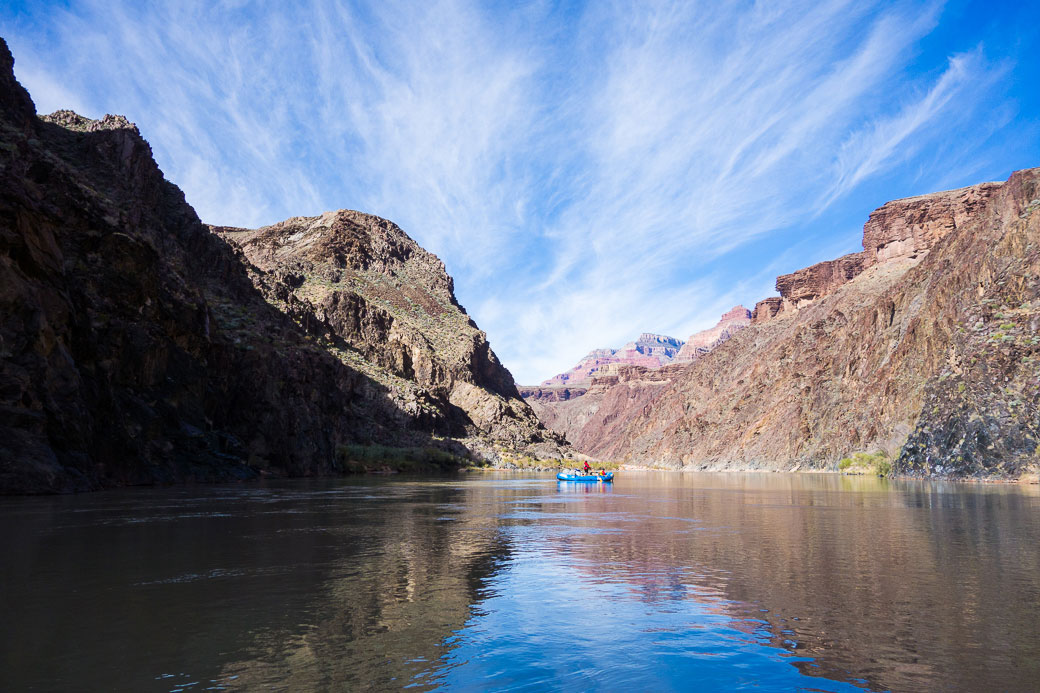
Nice write-up, Kristin. Let’s do it again!